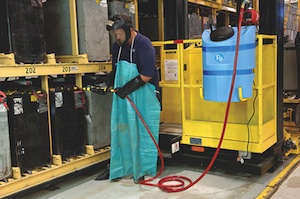Lift Truck Tips: Battery management replaces gut reactions and guesswork
Three practices can help users take the bite out of ‘the vampire in the battery room.’
Latest Material Handling News
New resource center for weighing and dimensioning Protective packaging roundup MODEX C-Suite Q&A: Troy Donnelly, Senior VP of Sales, Marketing, and Application, DMW&H When Just-in-Time Just Doesn’t Work Recycling coastline plastic into premium reusable packaging More Columns Anyone with a battery room could probably identify some things they’d like to improve. The expensive hub for increasingly expensive batteries can have a big impact on productivity, both by the minute and over the lives of those batteries. More often than not, the immediate needs of an operator will trump any overall program to monitor and maintain the health of individual batteries. To put it mildly, this can result in some waste. Harold Vanasse, vice president of sales and marketing for Philadelphia Scientific, puts it less mildly.
Anyone with a battery room could probably identify some things they’d like to improve. The expensive hub for increasingly expensive batteries can have a big impact on productivity, both by the minute and over the lives of those batteries. More often than not, the immediate needs of an operator will trump any overall program to monitor and maintain the health of individual batteries. To put it mildly, this can result in some waste. Harold Vanasse, vice president of sales and marketing for Philadelphia Scientific, puts it less mildly.
“I sometimes say there’s a vampire in the battery room sucking the life blood out of an organization,” says Vanasse. “There’s a lot of money spent there, but it’s often overlooked.”
The problem with battery room waste is that it’s very hard to quantify, especially when some wasteful acts are perceived as a quick way to get back to work. Vanasse says each of the lean methodology’s eight types of waste can be found in a battery room, and that battery management systems can cut into all of them. “As it rapidly spreads through other operations, lean thinking has not yet made its way to the battery room,” he says. “But this is the information age, so it’s only a matter of time.”
There are three primary steps a battery room owner can take to improve: rotation, watering and right-sizing. Rotation is often confused with a first-in, first-out (FIFO) approach, which is not ideal. With FIFO, there’s no way to tell if the first battery has completed its cycle, when it’s possible the second or third battery has. This can create a downward spiral of poorly charged batteries, less runtime and battery damage.
Just as poor rotation practices consist of guesswork and bad habits, battery watering is rarely optimal and can be just as damaging to equipment and productivity. “Some top off their batteries frequently, and some just water every Friday,” says Vanasse. “But it is possible to over-water and under-water a battery.”
The best time to water is after a full charging cycle, and it’s better to not simply use a bucket. Vanasse says about 70% of users water manually, at about one minute per cell. That adds up to more than 15 minutes per battery, whereas a battery watering system can ensure the job is done well in five minutes or less. Some can water an entire battery in just 15 seconds.
When a battery management system is installed, Vanasse said about half of users find they have too many batteries, and half don’t have enough. For operations with big seasonal shifts in volume, battery management system can inform battery inventory strategy year-round, as opposed to building a battery room around seasonal peaks. “The old philosophy is one charger and three batteries for each lift truck,” says Vanasse. “By pooling and effectively managing those batteries, it’s often possible to reduce battery inventory by one per lift truck.”

Article Topics
Columns News & Resources
New resource center for weighing and dimensioning Protective packaging roundup MODEX C-Suite Q&A: Troy Donnelly, Senior VP of Sales, Marketing, and Application, DMW&H When Just-in-Time Just Doesn’t Work Recycling coastline plastic into premium reusable packaging Fresh food, anyone? RPCs protect in the supply chain Why Isn’t Your Loading Dock Connected to Your Supply Chain? More ColumnsLatest in Materials Handling
ASME Foundation wins grant for technical workforce development The (Not So) Secret Weapons: How Key Cabinets and Asset Management Lockers Are Changing Supply Chain Operations MODEX C-Suite Interview with Harold Vanasse: The perfect blend of automation and sustainability Consultant and industry leader John M. Hill passes on at age 86 Registration open for Pack Expo International 2024 Walmart chooses Swisslog AS/RS and software for third milk processing facility NetLogistik partners with Vuzix subsidiary Moviynt to offer mobility solutions for warehouses More Materials HandlingAbout the Author
Subscribe to Materials Handling Magazine

Find out what the world's most innovative companies are doing to improve productivity in their plants and distribution centers.
Start your FREE subscription today.
April 2024 Modern Materials Handling

Latest Resources










